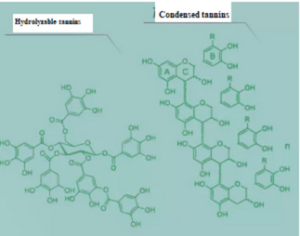Dietary inclusion of antibiotics for growth promotion in farm animal production has be a common practice for several decades. Resulting in increased efficiency levels in animal production.
- However, the use of antibiotic growth promoters has been widely associated with the promotion and/or selection of antibiotic-resistant microorganisms in farm animals (Chattopadhyay, 2014).
Extensive research has been conducted over the past two decades to look for
natural alternatives to antibiotics in feed. Plant compounds (or phytogenic compounds) have been attributed as great potential alternatives to AGPs (
Yang et al., 2015).

Amongst these,
vegetable tannins have drawn considerable attention and are probably some of the most studied compounds. This is especially true for ruminants.
Chemical structure and presence of tannins
Tannins are a heterogeneous group of phenolic compounds with diverse structures that share their abilities to bind and precipitate proteins.
They are usually classified into 3 main groups:
- Hydrolyzable tannins (HT)
- Condensed tannins (CT) (also called proanthocyanidins)
- Phlorotannins (PT)

The first 2 groups are found in terrestrial plants while PTs are found only in marine brown algae.
Tannins are widely distributed amongst the plant kingdom, being especially abundant in nutritionally important forages, shrubs, cereals and medicinal herbs (Salunkhe et al., 1982, Wang et al., 1999).
Tannins tend to be more abundant in the vulnerable
parts of plants, e.g., new leaves and flowers (Terrill et al., 1992,
Van Soest, 1982,
Frutos et al. , 2004).
Chemical structures and tannin concentrations vary greatly between plant species, growth stages and growth conditions.
Biological activity of tannins
Tannins serve as part
of the plant’s defense system against pathogen invasion and insect attacks. Thest possess numerous biological activities, such as:
- Antimicrobial properties
- Antiparasitic properties
- Antioxidant capacity
- Antiviral properties
These activities vary greatly depending on the chemical composition and structure of tannins. As well as due to other factors like: microorganism species, growth stages and/or host species (Hoste et al., 2006,
Hoste et al. , 2012).
Use of tannins in ruminants
Tannins, especially CTs, are widely distributed in nutritionally important forages, trees, and shrubs.
Condensed tannins may have beneficial or harmful effects for ruminants, depending on:
- The amount consumed by the animals
- Type and chemical structure
- The composition of the rest of the diet (especially the concentration of CP) (Mueller-Harvey, 2006)
It is generally believed that the presence of CTs in tempered forages at low to medium concentrations (<50 g/kg DM) can benefits ruminant by
improving protein utilization, without negatively affecting feed intake nor nutrient digestibility (
Barry and Mcnabb, 1999,
Waghorn, 2008).
Their capacity to precipitate proteins, as well as their antimicrobial, antiparasitic and antioxidant activities are probably the main reasons to consider the inclusion of tannins in ruminant diets.
Waghorn (2008)showed that when feeding forages as a single diet, an amount of approximately(30 g TC/kg DM) condensed tannins in L. corniculatus proved to be
beneficial for ruminant production. On the other hand, CTs found in
Hedysarum coronarium and
L. pedunculatus ( with concentrations greater than 50 g/kg DM) did not seem to offer any other productivity benefit than
mitigating parasite impacts.
Low to medium concentrations of condensed tannins can benefit the efficiency of ruminant production. As these reduce protein degradation within the rumen, which
increases the amount of dietary protein that reaches the small intestine and is absorbed (Wang et al., 1994,
Wang et al. , 1996).
Read full article
here 
 The first 2 groups are found in terrestrial plants while PTs are found only in marine brown algae.
Tannins are widely distributed amongst the plant kingdom, being especially abundant in nutritionally important forages, shrubs, cereals and medicinal herbs (Salunkhe et al., 1982, Wang et al., 1999).
Tannins tend to be more abundant in the vulnerable parts of plants, e.g., new leaves and flowers (Terrill et al., 1992, Van Soest, 1982, Frutos et al. , 2004).
Chemical structures and tannin concentrations vary greatly between plant species, growth stages and growth conditions.
Biological activity of tannins
Tannins serve as part of the plant’s defense system against pathogen invasion and insect attacks. Thest possess numerous biological activities, such as:
The first 2 groups are found in terrestrial plants while PTs are found only in marine brown algae.
Tannins are widely distributed amongst the plant kingdom, being especially abundant in nutritionally important forages, shrubs, cereals and medicinal herbs (Salunkhe et al., 1982, Wang et al., 1999).
Tannins tend to be more abundant in the vulnerable parts of plants, e.g., new leaves and flowers (Terrill et al., 1992, Van Soest, 1982, Frutos et al. , 2004).
Chemical structures and tannin concentrations vary greatly between plant species, growth stages and growth conditions.
Biological activity of tannins
Tannins serve as part of the plant’s defense system against pathogen invasion and insect attacks. Thest possess numerous biological activities, such as: